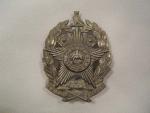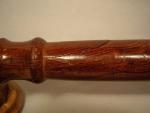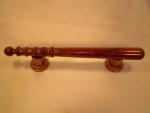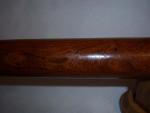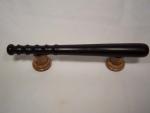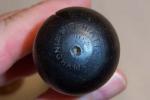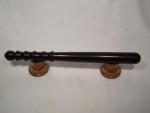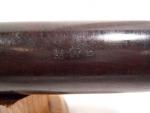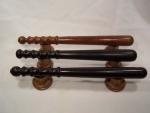-
Posts
6,486 -
Joined
-
Last visited
-
Days Won
10
Content Type
Profiles
Forums
Blogs
Gallery
Events
Store
Everything posted by Brian Wolfe
-
Leeds City Police In 1836 the City of Lees, in northern England, formed its first police department. In 1974 under the Local Government Act of 1972 it was amalgamated with the Bradford City Police along with part of the West Yorkshire Constabulary to form the West Yourkshire Police. The helmet plate featured here is made of nickel rather with later ones being lighter and chromed. This, I have been informed, places the date of the plate to before 1950. Regards Brian
-
Hello, You have a nice example of a British Police Helmet also known as a Custodian's Helmet. From the helmet plate on the front you can tell it has the Queen's Crown and the ciper of Queen Elizabeth II. The value of these runs from around $60.00 to $80.00 depending on the quality and rarity of the helmet plate. You can see many examples for sale on eBay to give you an idea of the price range. The number is the Police Constable's number and what I think is his last name. I suppose it would be possible to find out more information about this officer since you know the police department (on the helmet plate), his last name and best of all his number. A very nice example and quite complete. I hope this is of some help. Regards Brian
-
I don't have a lot of knowledge on the topic but I do a lot of shopping and I've never seen these leaves on any Japanese badges. Are you sure it is Japanese? I will be watching your post to see what the Japanese collectors have to say, and learn something for myself as well. Regards Brian
-
A beautiful specimen. An interesting configuration to the ribbon. Thanks for letting us view your new addition. Regards Brian
-
Hello Tracy and welcome. I share my fellow member's eagerness to read more from you. Regards Brian
-

My man cave
Brian Wolfe replied to perce's topic in Germany: Third Reich: Uniforms, Headwear, Insignia & Equipment
Hello Perce, Very nice collection and a great room as well. Regards Brian -
The answer to the question: What does the name taser mean? Spasm was all around the answer and I have a feeling he knows but is just having fun with us. Well done Spasm. The developer of the taser was John Higson Cover (1920 - 2009). When he was a young boy he read a lot of adventure stories featuring Tom Swift. Tom developed an electric rifle which was non-lethal. When Mr. Cover developed his device this story came to mind so he decided to name his invention after the action hero, therefore taser stands for: Thomas A. Swift's Electric Rifle. Regards Brian
-
Hello Mervyn, These are not allowed in Canada except for use by the police. The greatest threat to the public is that criminals would use them if they were allowed to legally be sold to the general public. I know that the U.S. has experienced these problems as well as with the mis-use of pepper spray, which for the most part, is prohibited in Canada for use by the public. Regards Brian
-
This final photo of the Leicestershire Police truncheon shows what can happen when the wood grain is not straight from tip to pommel. The "figured" grain of this truncheon allowed the grain to "tun out" just above the handle causing it to crack when applied to a target. This could be a case where an attempt to save money could have put the officer at risk by suppling cheap and faulty equipment, or "crap" as my friend Jes would say. I hope you like this little collection and I further hope you will add to this post if you are able. Regards Brian
-
The last truncheon of this series is from the Leicestershire Police. While this is not marked it was sent to me by a former police offier who served there and he stated this was one of his own truncheons. He also freely used the term "crap" when describing the truncheons of the 1960 - 1970 peroid from which this is an example. As you can see the wood grain is quite evident and, I think, quite attractive. In the last photo to this session you will see why, even though it my "look" like a nice truncheon, the term "crap" may be right on the mark. The length is 15 1/2 inches with a width being 1 1/2 inches.
-
To today's youth the police truncheon probably seems almost medievil when compared with pepper spray, stun guns (tasers) and extendable batons (asp). Before we relegate the truncheon to some barbaric past in policing we should look at the purpose of the truncheon as it relates to ite modern counterparts. A truncheon is used to incapacitate a person commiting a crime or attempting to resist arrest. That's pretty basic and also pretty well what pepper spray, the taser and asp are employed to do. Many tend to conjure up images of the cop beating a criminal about the head with his truncheon. While there may be some truth in this, however, if the officer knows how to fully use his truncheon he can render the old lady (only kidding) to a state where they are more manageable and "cooperative". This is due to those winderful pressure points so generously distributed throughout the human body. A good example of one of these points is in the area to the side or the leg above the knee and below the hip, also known as the outter thigh. This area is home to one of my personal favourite targets, the femoral nerve. One shot with your truncheon, or by driving your knee into this area, renders the leg completely useless. While the effects are only temporary the criminal is not going anywhere after this area has been introduced to the application of force. There are several other great little pressure points just begging to be explored with the application of the truncheon but this is not the place to mention them. My point is that there are alternatives to applying blunt force trauma to the cranium. So, while there are new gadgets on the market the good old truncheon can still be a very good "friend" while convincing someone to come along peacefully. Anyone who has used pepper spray and not paid attention as to whether you were up wind or downwind of the suspect will appreciate one of the other alternatives. The taser seems like a good idea but then again it can be rather high profile when used. Especially so when the recipient of in the neighbourhood of 50,000 volts is flopping around on the ground like a fish out of water. Every "Do Gooder" within range will have this documented on their cell phone and the video on You tube within minutes. At times it is all a matter of preceptions. I'm not sure if everyone knows this but some manufacturers of the asp (extendable baton) have designed them so that when deployed with the flick of the wrist/arm action that the sound is that of a shotgun being cocked. It certainly gets "thier" attention; lets hope that is always your attention. Before we get to the three truncheons, which are really the subject of this post, I would like to pose a question for the reader; a mini quiz just for us. What does "Taser" stand for? Please no cheating by looking on Google and the like. I'll answer the question at the end of the weekend (Sunday) if no one gets it by then. The photo below is of three truncheons from my collection. From front to back they are, Metropolitan Police, one made by Haitt & Co. and one from the Leicestershire Police. I'll describe each in more detail in the following posts to this thread. Regards Brian
-

Light Brigade Medals
Brian Wolfe replied to Hugh's topic in Great Britain: Orders, Gallantry, Campaign Medals
A great story and a noble action of the part of Mr. Kent. Thanks for sharing this with us. Regards Brian -
Make that a fourth invitation.
-
A very interesting post Mervyn. I wonder just how well these worked in the field as saws. Most muli-purpose tools usually work poorly for both intentions, in my opinion, however, that is in the area of wood working and not military. Have any of the members experimented with such weapons/saws? If so, lets hear from you. Regards Brian
-

EK 1914 period-repaired 1914 ek1
Brian Wolfe replied to Eric Stahlhut's topic in Germany: All Eras: The Iron Cross
Hello Eric, I too agree that a period repaired Iron Cross, or any medal for that matter shows a lot of character. The idea that the original medal was awarded (indirectly) by the Kaiser himself must have played greatly in any decision to have the medal repaired rather than simply purchasing a replacement. Thanks for posting this interesting piece. Regards Brian



